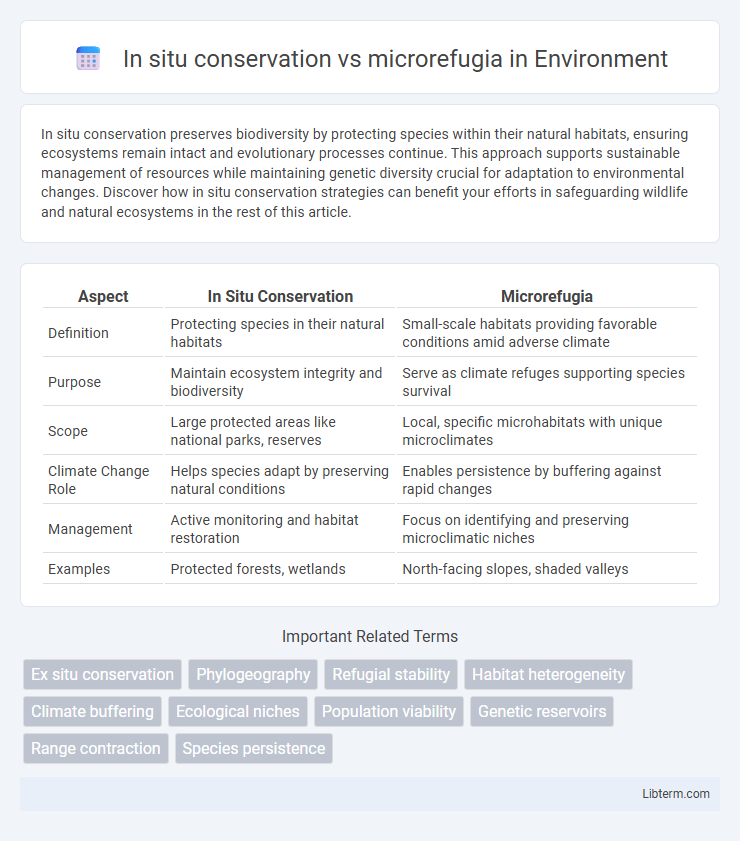In situ conservation preserves biodiversity by protecting species within their natural habitats, ensuring ecosystems remain intact and evolutionary processes continue. This approach supports sustainable management of resources while maintaining genetic diversity crucial for adaptation to environmental changes. Discover how in situ conservation strategies can benefit your efforts in safeguarding wildlife and natural ecosystems in the rest of this article.
Table of Comparison
| Aspect | In Situ Conservation | Microrefugia |
|---|---|---|
| Definition | Protecting species in their natural habitats | Small-scale habitats providing favorable conditions amid adverse climate |
| Purpose | Maintain ecosystem integrity and biodiversity | Serve as climate refuges supporting species survival |
| Scope | Large protected areas like national parks, reserves | Local, specific microhabitats with unique microclimates |
| Climate Change Role | Helps species adapt by preserving natural conditions | Enables persistence by buffering against rapid changes |
| Management | Active monitoring and habitat restoration | Focus on identifying and preserving microclimatic niches |
| Examples | Protected forests, wetlands | North-facing slopes, shaded valleys |
Introduction to In Situ Conservation and Microrefugia
In situ conservation preserves biodiversity by protecting species within their natural habitats, maintaining ecological processes and evolutionary dynamics. Microrefugia are small, localized habitats that provide stable environmental conditions allowing species to survive during adverse climate fluctuations. Both approaches support species persistence, with in situ conservation focusing on broader ecosystem protection, while microrefugia emphasize localized climate resilience.
Defining In Situ Conservation
In situ conservation is the preservation of species directly within their natural habitats, maintaining ecosystems and genetic diversity in the environments where species have evolved. This approach supports dynamic processes such as natural selection and ecological interactions, essential for species adaptation and survival. Microrefugia, small areas offering favorable conditions during climatic fluctuations, serve as critical survival spots but are distinct from the broader habitat management practiced in in situ conservation.
Understanding Microrefugia
Microrefugia are small, localized areas where species persist during unfavorable climatic conditions, serving as critical reservoirs for biodiversity within broader landscapes. Unlike traditional in situ conservation that emphasizes stable habitats across larger regions, microrefugia provide unique microclimates that buffer species against environmental extremes. Understanding microrefugia enhances conservation strategies by identifying key habitats that enable species survival and facilitate their long-term resilience amid climate change.
Key Differences Between In Situ Conservation and Microrefugia
In situ conservation involves preserving species within their natural habitats to maintain ecosystem stability and genetic diversity, while microrefugia are small, localized areas that provide suitable conditions for species survival during climate fluctuations. Key differences include scale, as in situ conservation covers broader natural environments, whereas microrefugia are limited zones offering climatic shelter. Furthermore, in situ conservation targets long-term ecosystem processes, whereas microrefugia function as temporary sanctuaries buffering species against environmental stress.
Ecological Importance of In Situ Conservation
In situ conservation preserves genetic diversity and ecosystem processes by maintaining species within their natural habitats, ensuring long-term ecological stability. It supports dynamic interactions among organisms and their environment, fostering adaptation to evolving climate conditions and threats. This approach safeguards critical habitats and promotes biodiversity resilience, unlike microrefugia which serve as small, localized refuges for species under environmental stress.
Microrefugia: Role in Climate Change Resilience
Microrefugia are small, localized habitats that provide stable environmental conditions, allowing species to survive amid broader climate fluctuations. Their role in climate change resilience is critical as they act as natural shelters preserving biodiversity and genetic diversity when larger ecosystems experience stress. These microrefugia support in situ conservation by maintaining species populations in situ, serving as reservoirs for future landscape restoration and adaptation strategies.
Species Survival: In Situ Conservation vs Microrefugia
In situ conservation ensures species survival by maintaining natural habitats, allowing organisms to adapt to environmental changes within their native ecosystems. Microrefugia offer critical refuge microhabitats with favorable microclimates that support species persistence during periods of climate stress or habitat fragmentation. Both strategies are essential for biodiversity preservation, with in situ conservation providing long-term ecological stability and microrefugia enhancing short-term species survival under adverse conditions.
Challenges and Limitations of Each Approach
In situ conservation faces challenges such as habitat fragmentation, climate change impacts, and limited protection against invasive species, which can reduce population viability over time. Microrefugia offer a targeted approach to preserving species in localized, climatically stable areas but are limited by their small size, potential isolation, and vulnerability to stochastic events. Both strategies require careful spatial planning and long-term monitoring to adapt to environmental changes and ensure genetic diversity maintenance.
Integrating In Situ Conservation and Microrefugia Strategies
Integrating in situ conservation with microrefugia strategies enhances biodiversity protection by preserving species within their natural habitats while leveraging small, favorable microhabitats that buffer against climate change impacts. Microrefugia act as critical climate-stable zones where vulnerable species can survive environmental fluctuations, complementing broader in situ efforts. This synergy supports ecosystem resilience by maintaining genetic diversity and facilitating species adaptation in situ, essential for long-term conservation success.
Future Perspectives in Conservation Biology
Future perspectives in conservation biology emphasize integrating in situ conservation with microrefugia identification to enhance species persistence under climate change. Protecting natural habitats while pinpointing microrefugia--small areas offering stable microclimates--enables targeted management of climate-sensitive species. Advances in remote sensing and ecological modeling improve the detection of these microrefugia, facilitating adaptive conservation strategies to mitigate biodiversity loss.
In situ conservation Infographic

 libterm.com
libterm.com